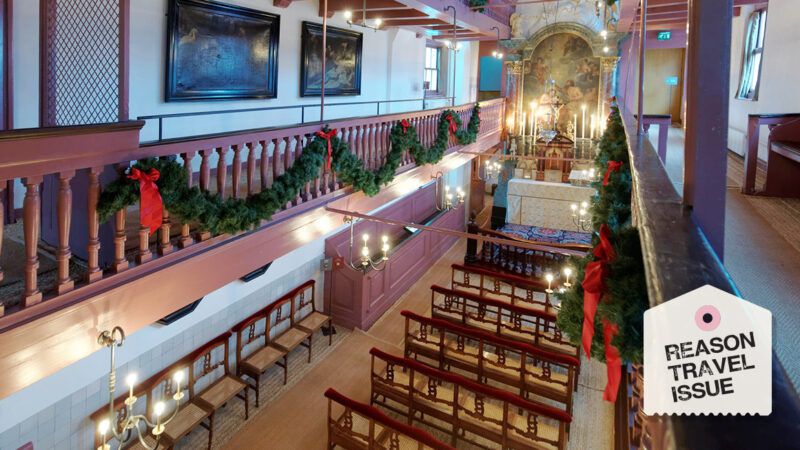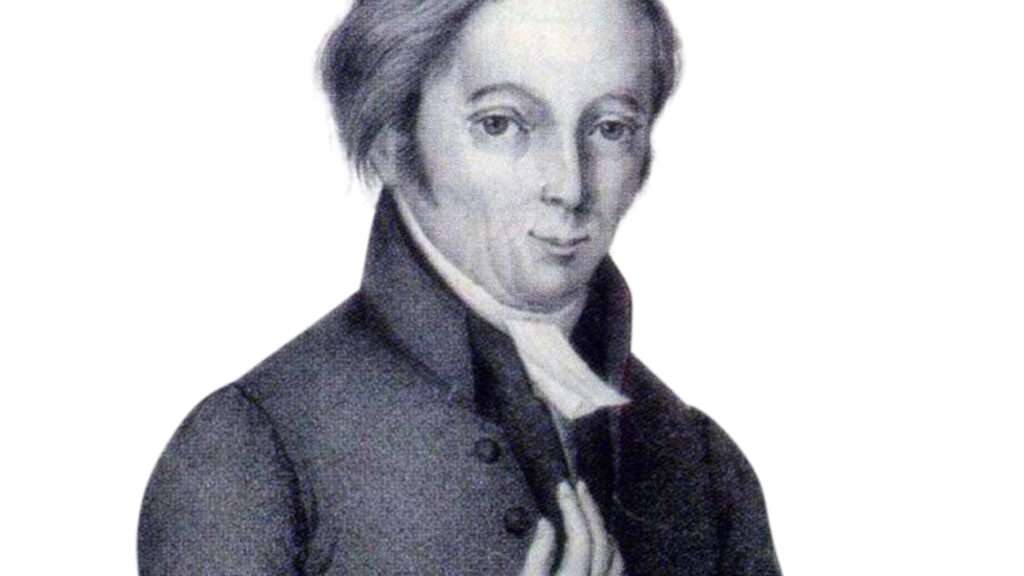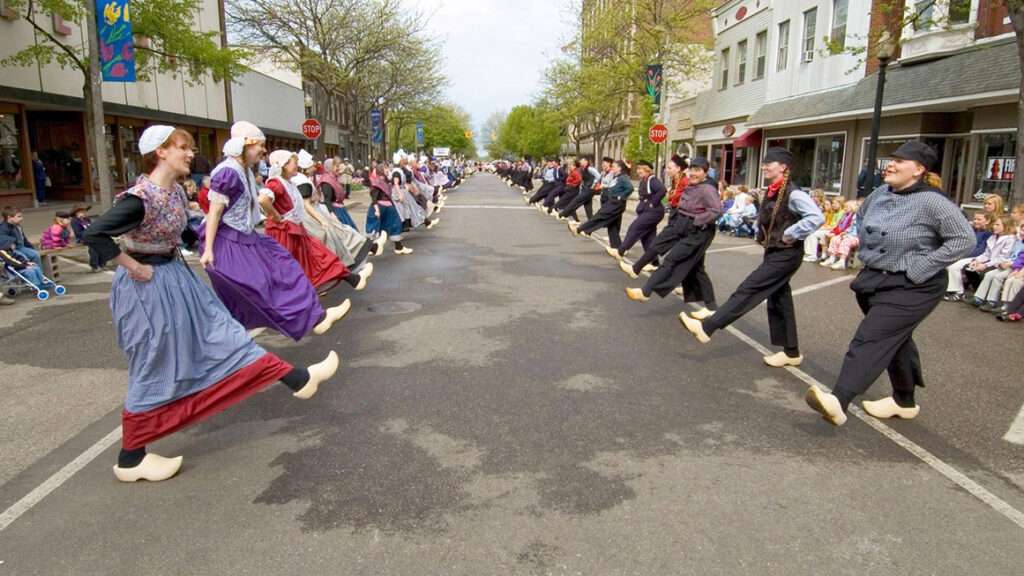Religious Dissenters Fled Holland (The Netherlands) and Established Holland (Michigan)
In response to disagreements within the Dutch Reformed Church, some believers packed up and left.

This is part of Reason's 2025 summer travel issue. Click here to read the rest of the issue.
In his 1970 classic Exit, Voice, and Loyalty, Albert O. Hirschman explored three ways people can respond to institutional failure: by standing by the institution anyway, by speaking up to agitate for change within the institution, or by leaving the institution in protest. The European wars of religion, and persistent attempts by the victors in those conflicts to hem in the losers, produced manifold examples of all three.
In 1834, a Calvinist minister in the Netherlands named Hendrik de Cock—fed up with theological liberalization within the official Dutch Reformed Church and especially with the church hierarchy's decision to prohibit him from speaking against what he saw as errors being preached by his fellow clergymen—led some 120 congregations in breaking away to form the rival Reformed Churches in the Netherlands.
The move "did not go unchallenged by the authorities," explains the Free Reformed Churches of North America (FRCNA) website. "King William I invoked an old Napoleonic law which forbade unauthorized meetings of more than twenty persons, in order to prevent the people from worshipping outside the Dutch Reformed Church. The Secession churches were persecuted for a number of years. Some of their pastors were imprisoned, those who assisted them were often excessively fined and soldiers were quartered in the homes of these 'trouble makers.'"
Although William's son and successor lifted those restrictions a few years later, many secessionists had apparently had enough. De Cock's denominational schism had a trans-Atlantic second act when his fellow minister Albertus van Raalte led an exodus of dissenting Calvinists to the sparsely settled "western" United States. The charming lakefront town of Holland, Michigan, established by van Raalte and his flock in 1847, now stands as a testament to the promise of exit.

But packing up and leaving is only one possible response to persecution. "Not all the orthodox people in the Dutch Reformed Church went along with the Secession," notes the FRCNA. "There were those who shared the same objections with regard to doctrinal purity and church government with the Seceders, but they conscientiously felt that they should try to promote a return to orthodoxy within the Dutch Reformed Church." Here we see feelings of loyalty motivating the exercise of voice.
In fact, Hirschman's attempt to catalog the various forms of activism available in the face of institutional dissatisfaction misses at least a couple of additional possibilities. For one, his voice-exit-loyalty schema seems to overlook violent resistance—and the religious history of the Netherlands offers a vivid illustration of this option as well.

At the time of the Reformation, Holland—the country, not the town—was under the control of the Habsburgs, who were not inclined to tolerate anti-Catholic heresy. Over the course of the 16th century, the ruling family's efforts to suppress Protestantism grew more brutal, and petitions by Dutch nobles for an end to religious persecution went unheeded. A response eventually came in the form of iconoclasm (literally, rampaging through Catholic churches and destroying religious icons) and, under the leadership of William of Orange, war.
This "Dutch rebellion" would drag on for 80 years, culminating in the formal liberation of the Dutch Republic in 1648 as part of the larger Westphalia settlement. But no sooner did the Dutch Reformed Church come to prominence in the Netherlands than repression of other religions began. This brings us to yet another possible response to institutional failure, one that's hard to pithily capture in a word like voice or exit but that might be summed up as going underground.
As early as 1581, the "overt practice" of Catholicism was outlawed in the Netherlands. Perhaps because of the country's emergence out of the furnace of religious conflict, private worship continued to be permitted. This led to a historical curiosity: the creation of secret churches "hidden in plain sight" within homes and businesses. Catholics would gather in such places to receive the sacraments, according to the Netherlands Institute for Cultural Heritage, "frequently with the tacit consent of the authorities, who were often prepared to turn a blind eye for a small favor, as long as the churches remained unrecognizable from the outside."
One such church—carved out of the top floors of a canalfront row house in Amsterdam's red-light district—exists today as a monument to this slice of Dutch history. Visitors to the Museum Ons' Lieve Heer op Solder ("Our Lord in the Attic Museum") can ascend a winding staircase through an ordinary-looking 17th century manse before emerging into a spectacular multistory chapel, complete with statuary, triptychs, and altar.
Amsterdam of course boasts a multitude of world-renowned attractions, from the national Rijksmuseum to the dedicated Van Gogh and Rembrandt houses, from the home (now a museum) where Anne Frank and her family hid during the Holocaust to the city's famous red-light district, canal cruises, and coffee shops. But history enthusiasts may enjoy paying a visit to Our Lord in the Attic and experiencing, up close, one religious minority's clever strategy for avoiding persecution without resorting to either voice or exit.
If a European vacation is outside your budget, consider a trip to the other Holland, a Midwestern town of fewer than 35,000 residents that punches above its weight for tourism. There you'll find Dutch crafts for sale along the 8th Street shopping district, a chance to climb into America's only working windmill imported from the Netherlands at Windmill Island Gardens, and a tulip festival that draws tens of thousands of gawkers each spring. Within a short drive are the beaches of Lake Michigan (including one boasting Holland's historic "Big Red" lighthouse) and Saugatuck Dunes State Park, where visitors can hike alongside sand deposits reaching 200 feet tall or learn about the area's history and nature by taking a guided tour with Saugatuck Dune Rides.
Holland, Michigan, proudly bills itself as the "City of Churches," with an unusually high number of houses of worship per capita. Many of them are from within the Dutch Reformed tradition—a small reminder of the town's origin as a safe place for religious dissenters yearning to breathe free.
